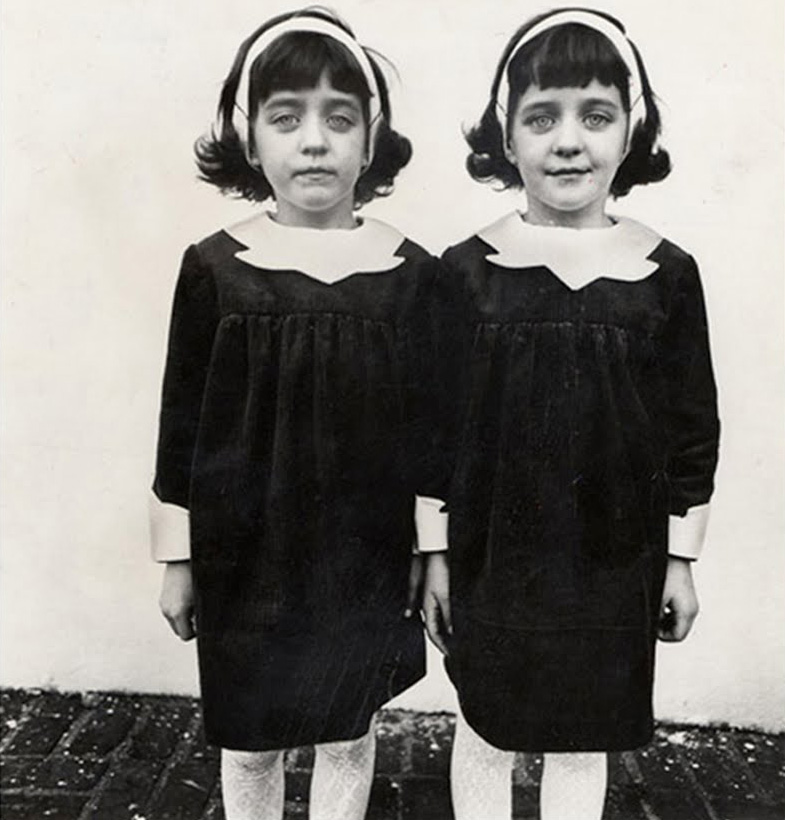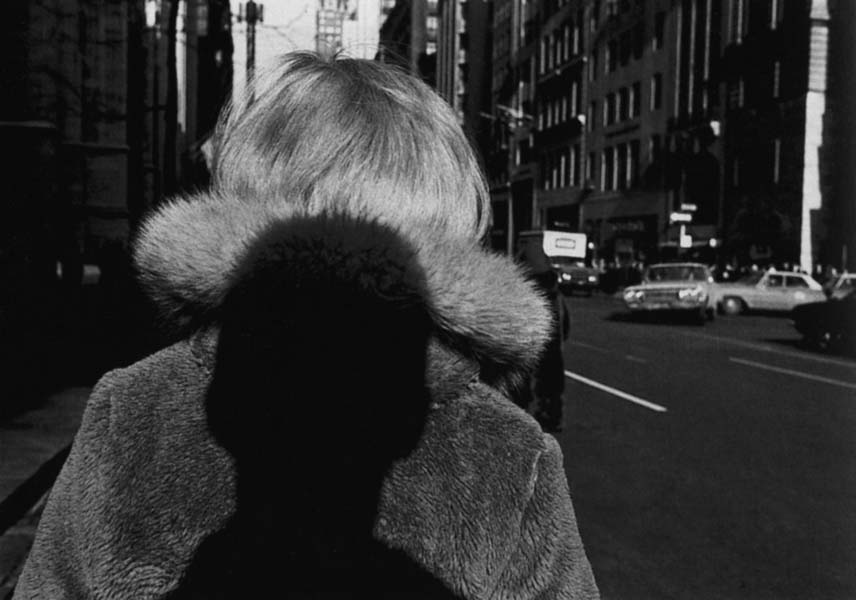
Diane Arbus, Identical twins, Roselle, NJ 1966 (archives.evergreen.edu)
July 7, 2018 marked the eleventh anniversary of John Szarkowski's death and I thought it fitting to look at his contribution to photography, specifically how this single exhibition shaped what we now know as street photography.
Fifty years ago the "New Documents" exhibition closed at the Museum of Modern Art in New York. The show featured ninety-four prints by three relatively unknown photographers; Diane Arbus, Lee Friedlander and Garry Winogrand. The exhibit was a landmark event for modern photography. The show, curated by John Szarkowski, the director of photography at the museum, inextricably linked the three photographers together and made their careers. The new student of photography should understand that at that time, except for the work of a handful of photographers, most museums did not have photography collections or departments. The photographs of Ansel Adams, Edward Steichen, Alfred Stieglitz and Edward Weston represent the type of work that did exist, if at all, in a museum. Few photography galleries existed. For the most part, photography was photography, not art. Because it was a mechanical process and perceived to be "easy" by most, easier than painting anyway, it was not taken seriously. One could argue that Szarkowski single-handedly changed that whole notion with this one exhibit. It took some time to take root, but "New Documents" set the movement in motion.
Szarkowksi succeeded Steichen at MOMA in 1962. He was only 37 and had a large pair of shoes to fill. Stiechen had curated the monumental "Family of Man" exhibition in 1955. It contained 500 images by 273 photographers both famous and unknown and was built on a theme of the human experience…birth, death, love, joy, sorrow. The show was a huge success and toured the world. The book is still popular. While "Family of Man" was a landmark exhibition it did not break any new ground in the photographic vocabulary and relied on existing documentary traditions. It was more about the subjects of the photographs than the photographs themselves. Photojournalism was socially responsible and served to report, inform and affect change. Arbus, Friedlander and Winogrand had no such goals. They selfishly photographed for themselves. Szarkowski wrote in his introduction to "New Documents"1, "In the past decade this new generation of photographers has redirected the technique and aesthetic of documentary photography to more personal ends. Their aim has been not to reform life but to know it, not to persuade but to understand. The world, in spite of its terrors, is approached as the ultimate source of wonder and fascination, no less precious for being irrational and incoherent." His egalitarian view that anyone, anywhere, anytime could create a great photograph worthy of comparison to the masters shaped the future of photography and has become commonplace within the photo sharing websites of today's digital age, where stars are born and die every day.
1967 was the year of the "summer of love" yet it was a turbulent year in America. The country was deeply involved in Vietnam and civil disobedience plagued cities across the country. Riots in Detroit required the National Guard to restore order and left dozens of people dead. The Equal Rights Amendment would not be passed for another five years. Cameras used film and photographers had darkrooms. With so many social and political events ripe for documentary photography, 1967 seemed an inauspicious year to present an exhibit of photographers so preoccupied with their own personal agendas.

Lee Friedlander, New York City 1965 (sfmoma.org)
"New Documents" received a cool reception. Jacob Deschin wrote, "The observations of the photographers are noted as oddities in personality, situation, incident, movement, and the vagaries of chance," in his New York Times review2. Nine years later Szarkowski would take an even bolder risk with "William Eggleston's Guide," which was met with even more skepticism. Today Eggleston is considered to have set the stage for fine art color photography3 at a time when the materials and medium were far more limited than they are today.
What did Arbus, Freidland and Winogrand have in common other than working in black and white? They all used small 35mm cameras, although Arbus eventually moved up to a 2-¼ square Rolleiflex. The photographs of the two men are closer to each other than the work of Arbus is to either of them, Both men realized the importance of photographic context, but Friedlander was inclined to often deal only with the elements of place while Winogrand was self-admittedly interested in people. While Arbus may have taken photos on the street, she was primarily a portraitist and is lumped into the street photography genre solely because of her inclusion in "New Documents." Her methodology had little to do with the "catch as catch can" approach of Friedlander and Winogrand and depended on cultivating a trust with her subjects, sometimes over a period of time. Perhaps Szarkowski sums it up best in this excerpt from a museum press release4 for the exhibit, "What unites these three photographers is not style or sensibility; each has a distinct and personal sense of the use of photography and the meanings of the world. What is held in common is the belief that the world is worth looking at, and the courage to look at it without theorizing."

Garry Winogrand, World's Fair 1964 (masters-of-photography.com)
In 1967 street photography was not a new invention. One could argue that the early work of Atget, Brassai and Kertesz was essentially "street photography", although Brassai posed his subjects on occasion. And of course there were Henri Cartier-Bresson, Helen Levitt and Lisette Model (whom Arbus studied under) and Robert Frank's opus from ten years earlier, The Americans,. Winogrand himself was profoundly influenced by Walker Evans, American Photographs. These works, however, relied more heavily on documentary traditions than the frivolity of Friedlander's storefront reflections or Winogrand's public relations. In an interview with John Pilson5 published in 2011 Tod Papageorge describes Sunday night get-togethers (including Joel Meyrowitz) at Garry Winogrand's house as being focused on discovering just what photography was, and wasn't. Papageorge goes on to say that much of the conversation was about photographic "problems" and strategies to solve them. How much information could be crammed on to a 24x36mm piece of film and still be coherent when viewed as a print? Must the horizon be level? What happens when you use flash? What happens when you use flash at a slow shutter speed? What happens to something when you photograph it? In an essay for the catalog for the exhibit, "The Social Scene"6, A.D. Coleman writes about "New Documents", "Increasingly asymmetrical, unbalanced, fragmented, even messy, especially in contrast to preceding photography, this work demanded of both photographer and viewer an openness to radically unconventional formal structures." With its snapshot view of the world, the work carried an authenticity that was not evident in the work of say, Eugene Smith, or the FSA photographers where it could be said that the photographs were not entirely candid, or entirely honest. Many of the visual mannerisms we now take for granted had not been seen before "New Documents" nor had such seemingly banal subject matter. The ways in which these three photographers used their cameras opened up a new visual vocabulary for generations of photographers. But it was John Szarkowski's willingness to take risks that expanded the borders of modern photography. It may be no idle claim that he was once referred to as "the man who taught America how to look at photographs."
Notes
1. Museum of Modern Art archives; press release, February 28, 1967;www.moma.org
2. The New York Times; July 9, 2007; www.nytimes.com
3. While color photography was commonplace by the 1960's it was nothing compared to today's technologies. Kodachrome was very sharp film but involved a proprietary process that only few color labs could afford. Hence, film had to be sent off for processing. At ASA 25 it was very slow and full sun would give an exposure of about f5.6 @ 250. C-41 color negative films were also slow but gave one additional f-stop at ASA 64. The various Ektachrome films were not nearly as fine grained as Kodachrome and the dyes in processed slides were not as stable as Kodachrome either. If not stored properly you could expect to find faded colors and fungus on old Ektachromes. We referred to High Speed Ektachrome of the 70's (ASA 160) as having "grain the size of golfballs."The biggest obstacle however for color to be used for so called "fine art" photography was the available processes for making prints. Conventional "C prints" of the time made from color negatives (or internegatives from slides) had dyes that were extremely fugitive. If displayed prints received significant light, natural or artificial, fading could be noticed in as little as a few years. Who wants a piece of art that needs to be kept in a closet? Also, color was never truly faithful even if printed by a professional lab. Dye transfer prints were the best color print available at the time and were relatively stable, but they were costly and only available from top tier professional photo labs. Cibachrome prints came later. While permanent, color fidelity was hit or miss and the process used toxic chemicals hazardous to home users. Consequently, most serious photographers who sought a place in "fine art" photography worked in black and white. Properly processed and stored silver gelatin prints should have an unlimited life.
4. Museum of Modern Art archives; press release, February 28, 1967;www.moma.org
5. John Pilson; "Taking Pictures", Tod Papageorge in Conversation with John Pilson"; Aperture #204, Fall 2011; New York
6. A.D. Coleman; "The Social Scene", The Ralph M. Parsons Foundation Photography Collection at the Museum of Contemporary Art, Los Angeles; Los Angeles;2000
posted by Greg Allikas, July 6, 2012
